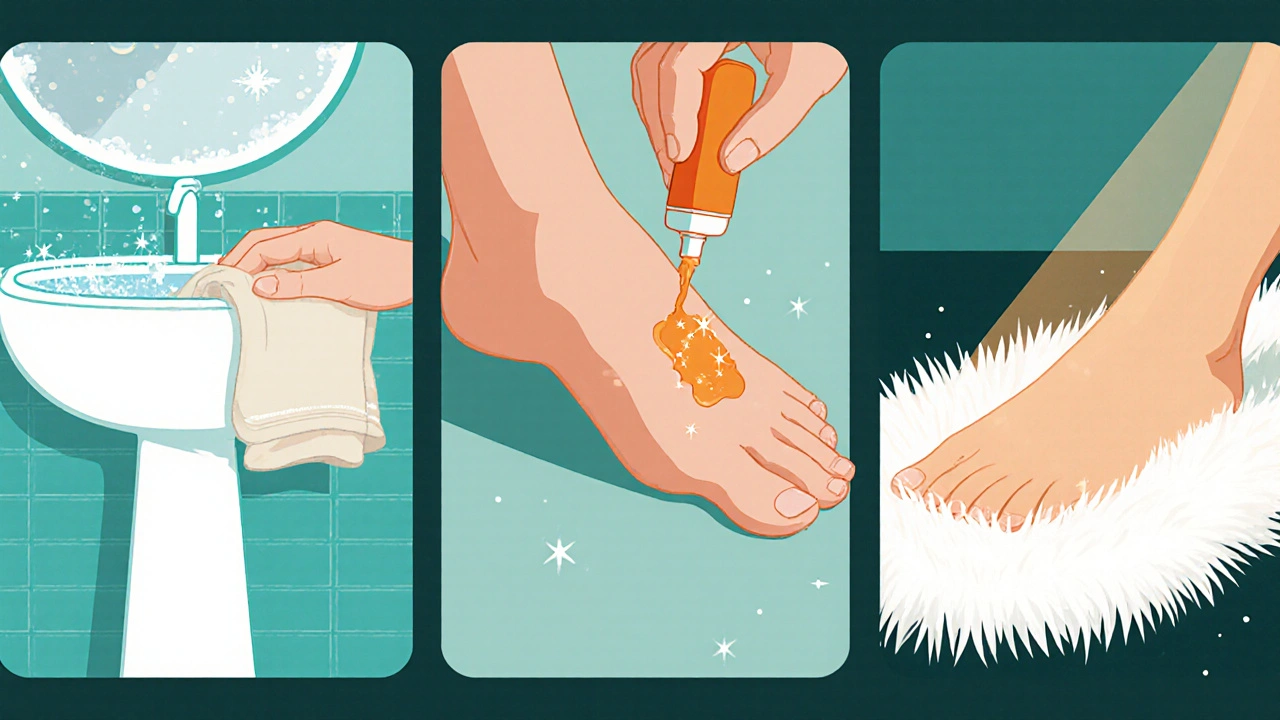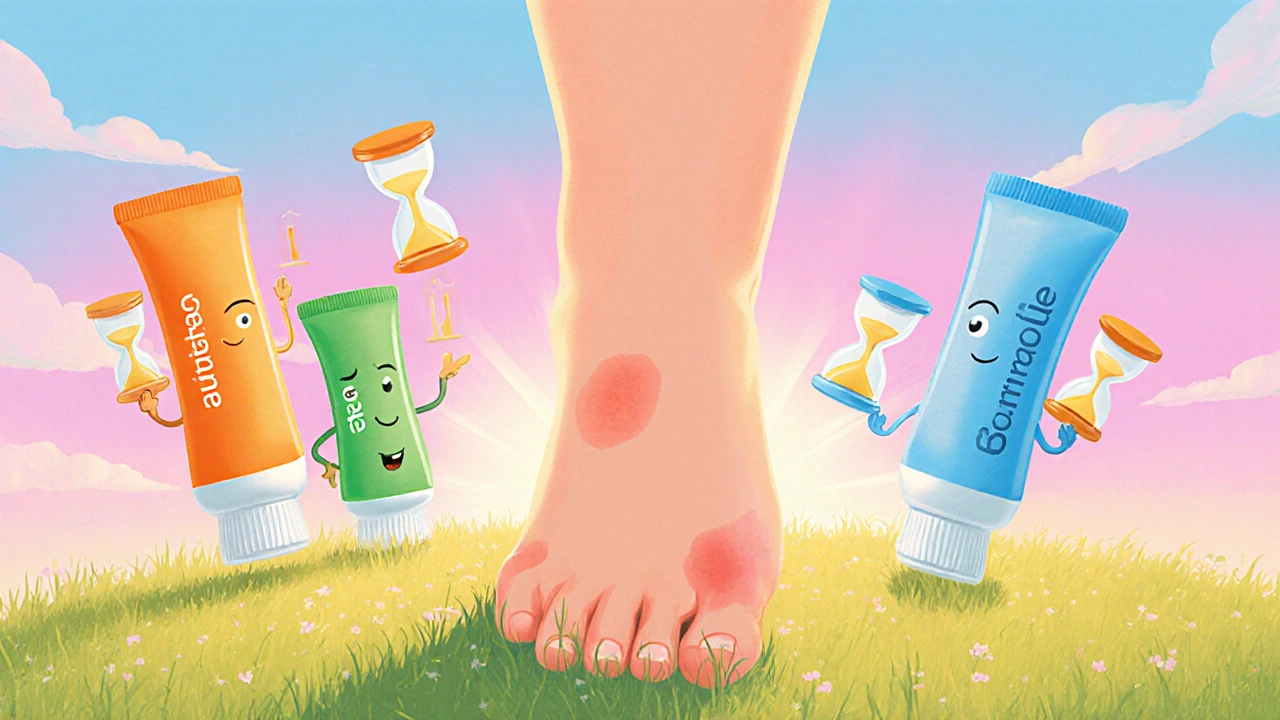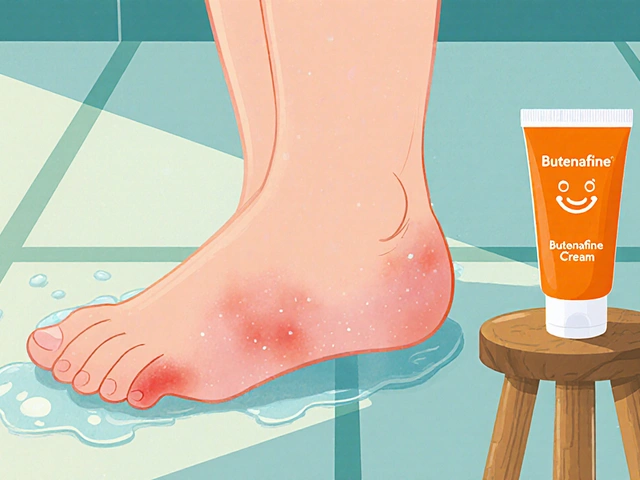Athlete's Foot Treatment Calculator
Calculate your optimal treatment duration based on Butenafine's effectiveness. The article states Butenafine typically works in 2 weeks for most cases with twice-daily application.
Treatment Comparison
When it comes to treating athlete's foot, Butenafine is a synthetic antifungal that blocks the growth of the fungi that cause the infection. The condition, known medically as Athlete's foot, affects millions of people worldwide, especially in warm, moist environments like public pools or gyms. If left untreated, it can spread to the toenails, the groin, or even cause secondary bacterial infections. This article explains why butenafine is a powerful solution, how to use it correctly, and how it stacks up against other common over‑the‑counter (OTC) antifungals.
Quick Takeaways
- Butenafine 1% cream works in as little as 2weeks for most cases of athlete's foot.
- It targets the cell membrane of dermatophytes, the fungi behind tinea pedis.
- Side‑effects are rare and usually limited to mild skin irritation.
- Compared with terbinafine and clotrimazole, butenafine shows faster symptom relief.
- Available without prescription in the UK, US, and many EU countries.
What Is Athlete’s Foot?
Athlete's foot, formally called tinea pedis, is a fungal infection of the skin on the feet. It is caused by a group of fungi known as Dermatophytes. These organisms thrive in warm, damp spaces and spread via direct contact or contaminated surfaces. Typical symptoms include itching, burning, scaling, and sometimes blistering between the toes. According to a 2023 CDC survey, about 15% of the U.S. population experiences tinea pedis each year, making it one of the most common skin conditions.
How Butenafine Works
Butenafine belongs to the benzylamines class of antifungal agents. It inhibits the enzyme squalene epoxidase, a key step in the synthesis of ergosterol - a vital component of the fungal cell membrane. Without ergosterol, the fungal cell becomes leaky and dies. Clinical trials have demonstrated cure rates of 85‑90% after a two‑week regimen, outperforming many older creams that often require four weeks.
Importantly, butenafine has a high affinity for the fungal enzyme but low affinity for human enzymes, which explains its excellent safety profile.

How to Use Butenafine Cream Correctly
- Wash and dry the affected area thoroughly. Moisture promotes fungal growth, so a dry surface is essential.
- Apply a thin layer of the 1% cream to the entire foot, not just the visible lesions. Include the spaces between the toes.
- Rub the cream gently until it disappears. Do this twice daily - once in the morning and once before bed.
- Continue the treatment for at least 2weeks, even if symptoms improve after 5‑7days.
- After completing the course, keep feet clean and change socks daily to prevent relapse.
If you notice severe redness, swelling, or if the infection spreads to the nails, consult a healthcare professional. In rare cases, oral antifungals may be needed.
Butenafine vs. Other OTC Antifungals
| Feature | Butenafine 1% | Terbinafine 1% | Clotrimazole 1% |
|---|---|---|---|
| Mechanism | Squalene epoxidase inhibition | Squalene epoxidase inhibition | Ergosterol synthesis inhibition (broad) |
| Typical treatment duration | 2weeks | 4weeks | 4weeks |
| Cure rate (clinical studies) | 85‑90% | 70‑80% | 65‑75% |
| Side‑effects | Rare - mild irritation | Occasional burning | Itching, redness |
| Availability (UK) | OTC, pharmacies & supermarkets | OTC, pharmacies | OTC, pharmacies |
The table shows that butenafine generally achieves faster symptom relief and higher cure rates, while maintaining a comparable safety profile.

Safety, Side Effects, and Precautions
Butenafine is classified as a Over‑the‑counter medication in most jurisdictions, meaning you can buy it without a prescription. The most commonly reported adverse events are mild skin irritation, burning, or itching at the application site. These reactions typically resolve within a few days after discontinuation.
People with known hypersensitivity to benzylamine derivatives should avoid it. Pregnant or breastfeeding women should consult a doctor before use, although no teratogenic effects have been reported.
The FDA (U.S. Food and Drug Administration) and the UK MHRA have both approved butenafine creams for the treatment of tinea pedis and tinea corporis, confirming its safety when used as directed.
Frequently Asked Questions
Frequently Asked Questions
How quickly does butenafine start working?
Most users notice reduced itching and scaling within 3‑5days, but a full cure usually requires a 2‑week course.
Can I use butenafine on fungal nail infections?
Butenafine cream is formulated for skin infections. For toenail fungus, oral antifungals or a nail lacquer containing ciclopirox are more effective.
Is it safe to apply butenafine on broken skin?
Avoid applying the cream to open wounds or severe cracks. Use a gentle barrier cream first, or seek medical advice.
Do I need a prescription to buy butenafine?
No. In the UK, the U.S., and most EU countries, butenafine 1% cream is sold OTC in pharmacies and major retailers.
Can I use butenafine together with other foot creams?
If you need a moisturizer, apply it after the butenafine has fully absorbed (about 10minutes). Avoid mixing with other antifungal agents to prevent reduced efficacy.
Bottom line: butenafine offers a fast, well‑tolerated, and readily available option for most cases of athlete's foot. Pair it with good foot hygiene, and you’ll likely see the infection cleared in under a month.


Nickolas Mark Ewald
October 17, 2025 AT 03:10I’ve used butenafine for a friend’s athlete’s foot and it cleared up in a couple weeks. The cream is easy to apply and doesn’t sting. Keeping feet dry is still the most important part.
Chris Beck
October 17, 2025 AT 04:10Brits think their meds are better but this stuff works fine it’s not rocket science!!
Rebecca Mitchell
October 17, 2025 AT 05:10Honestly the cream works faster than any other I tried.
Roberta Makaravage
October 17, 2025 AT 06:10When you consider the chemistry behind butenafine, you quickly realize that it attacks the fungal cell wall in a way most over‑the‑counter options merely graze. The squalene epoxidase blockade means the fungus can’t repair its membrane, leading to rapid cell death. This mechanism is shared with terbinafine, yet clinical data show butenafine finishes the job in half the time. Users often report itching subsiding within three to five days, which aligns with the pharmacodynamics. Moreover, the safety profile is impressive; most side‑effects are limited to a mild tingling that disappears once you stop using it. From a philosophical viewpoint, the pursuit of a swift cure reflects our desire to restore balance to the body swiftly. 🦶✨ It also reminds us that nature’s microbes are not invincible-they have weaknesses we can exploit responsibly. The convenience of a twice‑daily application fits into modern busy schedules without demanding complex regimens. Because the cream spreads easily, you can treat the interdigital spaces, which are often neglected. Consistency is key, though, so setting a reminder on your phone can help maintain the two‑week course. If you skip doses, you risk a resurgence, as the fungal spores can linger in moist environments. This is why foot hygiene-drying after showers and rotating socks-remains essential. In the broader context, the availability of butenafine without prescription democratizes access to effective treatment. It reduces the need for costly doctor visits for a condition that’s usually benign but annoying. Ultimately, the combination of rapid action, high cure rates, and low irritation makes butenafine a standout choice for athlete’s foot.
Lauren Sproule
October 17, 2025 AT 07:10I totally agree with what was said it’s a solid option for most people. Keep your feet dry and change socks often for best results. Also dont forget to apply the cream after you shower it helps lock in moisture.
CHIRAG AGARWAL
October 17, 2025 AT 08:10I don’t see why everyone makes a big deal out of butenafine – just slap on any antifungal and you’ll be fine.
genevieve gaudet
October 17, 2025 AT 09:10From a cultural perspective, the way we treat foot infections says a lot about our attitudes toward self‑care. People in some regions use home remedies, while others rely on modern creams like butenafine. Both approaches have value, and sharing knowledge across borders can only improve outcomes.
Patricia Echegaray
October 17, 2025 AT 10:10It’s no coincidence that big pharma pushes butenafine while downplaying older, cheaper options – they want us dependent on their products. The truth is hidden behind glossy ads and government approvals that favor corporate interests. Stay vigilant and question every “OTC” label you see.
Miriam Rahel
October 17, 2025 AT 11:10In conclusion, the comparative data indicate that butenafine’s cure rate of approximately 85‑90 % surpasses that of terbinafine and clotrimazole, which hover around 70 % and 65‑75 % respectively. Consequently, for practitioners seeking evidence‑based recommendations, butenafine should be considered the preferred first‑line therapy for tinea pedis.